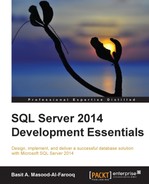Microsoft SQL Server is an enterprise database server that is the cornerstone of modern business applications and is in the center of the business processes of many leading organizations. The latest release of Microsoft SQL Server, SQL Server 2014, has many new features. These new features of SQL Server 2014 let you design, build, and deploy high-performance OLTP applications. Especially, the new in-memory technology of SQL Server 2014 helps you to design and implement high-performance OLTP applications. According to Microsoft, in some situations, implementing the new SQL Server 2014 in-memory technology for existing OLTP applications can improve the performance of these applications by 10 times. This book will provide you with all the skills you need to successfully design, build, and deploy databases using SQL Server 2014. Starting from the beginning, this book gives you an insight into the key stages of the SQL Server database process, provides you with an in-depth knowledge of the SQL Server database architecture, and shares tips to help you design the new database.
By sequentially working through the steps in each chapter, you will gain hands-on experience in designing, creating, and deploying SQL Server databases and objects. You will learn how to use SQL Server 2014 Management Studio and the advanced Transact-SQL queries to retrieve data from the SQL Server database. You will also learn how to add, modify, and delete data stored within a database. You will use Transact-SQL statements to create and manage advanced database objects that include scalar and table-valued functions, views, stored procedures, and triggers. Finally, you will learn about how the SQL Server 2014 relation engine works, how indexes and statistics improve query performance, and the new SQL Server 2014 in-memory technologies.
Chapter 1, Microsoft SQL Server Database Design Principles, explains the database design process and the architecture and working of the SQL Server 2014 Storage Engine. This chapter covers the database development life cycle in detail, including the normalization and denormalization process, benefits of choosing appropriate data types, and the functioning of the SQL Server 2014 Storage Engine.
Chapter 2, Understanding DDL and DCL Statements in SQL Server, introduces the reader to the SQL Server 2014 Transact-SQL language elements and SQL Server 2014 Management Studio (SSMS 2014). This chapter explains Transact-SQL DDL, DCL, and DML language elements in detail, and how you can use them to create, manage, and secure SQL Server 2014 databases, schemas, and tables. This chapter also shows you how you can use SQL Server Management Studio to create and manage SQL Server 2014 databases, schemas, and tables. Finally, this chapter covers the purpose of SQL Server 2014 system databases and highlights the advantages and disadvantages of database recovery models.
Chapter 3, Data Retrieval Using Transact-SQL Statements, demonstrates how to query data from tables, how to write multiple table queries, and how to group, organize, and pivot result set data. This chapter explores the basic form of the SELECT statement and how it can be used to query data from tables. This chapter also highlights the different categories of built-in T-SQL functions and how you can use them in your SELECT statements. This chapter also explains different techniques that you can use to combine data from multiple tables, how to organize the data, and how to generate the summary data by grouping or pivoting it. Finally, this chapter covers the purpose of the CTE and SQL Server 2014 windowing functions and how to use them to quickly solve complex analytical tasks.
Chapter 4, Data Modification with SQL Server Transact-SQL Statements, illustrates how to add, modify, and delete data in tables using Transact-SQL DML statements. This chapter covers how to add data to a table using the INSERT statement, how to delete the data using the DELETE statement, and how to update existing data using the UPDATE statement. This chapter also covers the SELECT…INTO, MERGE, and TRUNCATE TABLE statements, and it highlights the key new enhancements of these statements in SQL Server 2014.
Chapter 5, Understanding Advanced Database Programming Objects and Error Handling, covers reusable programming objects that includes views, stored procedures (normal and natively compiled), functions and triggers (based on either DDL or DML), SQL Server 2014 control-of-flow statements, and structured error handling blocks. This chapter shows you how you can declare and use variables and how you can use control-of-flow statements to control your program execution. Next, it explains the purpose of views, stored procedures, user-defined functions, and triggers, and highlights the guidelines and restrictions to design each of these programmable objects. This chapter also illustrates how to handle errors that occur within Transact-SQL batches and programmable objects using the TRY...CATCH construct.
Chapter 6, Performance Basics, explains performance-related features of SQL Server 2014. This chapter first explains the architecture of the SQL Server Relational Engine. Then, it introduces the architecture of the SQL Server 2014 in-memory technology. Next, it covers all SQL Server 2014 index types and how they can be used to achieve optimal query performance while reducing the overall response time. Then, it explores the architectural differences of B-tree, Bw-tree, and xVelocity columnstore indexes. Finally, it explains core performance topics such as SQL Server query optimization statistics, SQL Server transactions and locks, and tools that come with SQL Server 2014 Database Engine, which you can use to monitor and troubleshoot its Database Engine performance.
